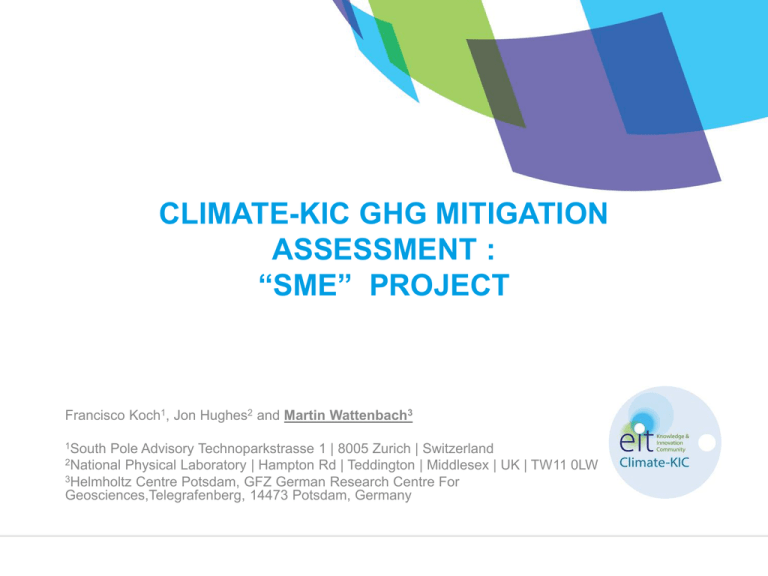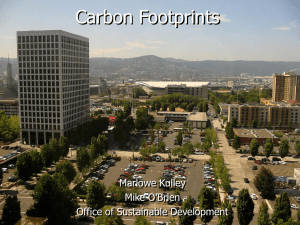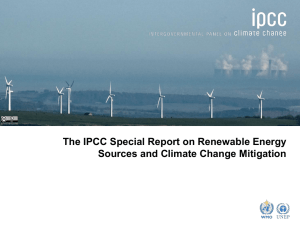Document
advertisement

CLIMATE-KIC GHG MITIGATION ASSESSMENT : “SME” PROJECT Francisco Koch1, Jon Hughes2 and Martin Wattenbach3 1South Pole Advisory Technoparkstrasse 1 | 8005 Zurich | Switzerland Physical Laboratory | Hampton Rd | Teddington | Middlesex | UK | TW11 0LW 3Helmholtz Centre Potsdam, GFZ German Research Centre For Geosciences,Telegrafenberg, 14473 Potsdam, Germany 2National GHG Mitigation Impact Assessment stepwise procedure Innovation projects (Steps 1-6) Step 1 Describe how the proposed project reduces GHG emissions (GHG mitigation story) Step 2. Indicate the main GHG sources that will be reduced by the project Step 3 Define the project unit and project boundary used for the assessment Step 4 Describe the baseline scenario Step 5 Calculate the estimated GHG Mitigation Impact Step 6 Leakage assessment Pathfinder projects Step 1 and 2 only Project type • Defining a project type ? 1. What does the KIC project result in? • • • • A new technology (equipment)? A less carbon intensive product or produce (e.g.. food )? A decision making tool (e.g. a low carbon urban planning tool)? A low carbon financial solution that deploys existing Low C Technologies? No emissions reductions Emissions reductions New Technology KIC PROJECT Outcome Low Carbon product Low -C decision making tools Deployment of Existisng Low C Technologies Case Study: Efficient City Farming 1. ECF is a Berlin based company using a unique combination of Aquaculture and Hydroponics in an urban environment 2. Allows for an annual production 24 t of fish and 35 t vegtables on just 2000 m² * * source: http://www.tomatenfisch.igb-berlin.de/ Impact Assessment Framework Step 1 + Step 2: Mitigation Approach of ECF + Targeted GHG Reducing transport emissions (including chilled transport of fish by plain or ship and last mile by customer) CO2 Reducing emissions due to reduced fertilizer demand CO2, N2O Reducing emissions linked to pesticides as well fungicides by using beneficial organisms CO2 Reducing emissions linked to grey water treatment by large scale water recycling CO2, N2O, CH4 Reducing electricity and heat related emissions by using a CHP system (~ 56 % lower emissions) CO2 Reducing on farm emissions by using CHP and fish CO2 emissions as greenhouse fertilizer CO2 Impact Assessment Framework Step 3: System boundary for assessment 1. Tomatoes: The full life cycle of the production of tomatoes (cradle to grave). 2. Fish: Only emissions that are linked to transportation. Impact Assessment Framework Step 4: Baseline scenario: 1. Tomatoes: Tomato demand in Berlin is met by imports from European Countries as well as domestic production in Germany. Netherlands, Spain, Belgium, Italy as well as Germany produce 90 % of the tomatoes consumed in Berlin. Non-European imports are neglected. 2. Fish: Consumed perch in Berlin is imported from Tanzania by plane. About 5 % of fish consumed in Germany is transported by plane with Nile perch being the most important (7182 t yr-1). Impact Assessment Framework Application Step 5: GHG mitigation potential assessment 1. Tomato production scenario: Growing tomato for Berlin consumers on 750 m² of an ECF greenhouse and building a new farm every second year. Emissions linked to the transportation and production of tomatoes. If we only consider tomatoes grown during the warm season ECF tomatoes produce 83 % and 77 % less emissions than tomatoes from Spain and Italy, respectively. Impact Assessment Framework Application Step 5: GHG mitigation potential assessment 2. Fish production scenario: Replacing Nile Perch produced in Tanzania by ECF fish. Air-transport emissions of the most important fish impoters (only air transport). Impact Assessment Framework Application Step 5: GHG mitigation potential assessment 1. Replacing 16.5 t summer tomatoes by ECF crops shows a great potential for mitigating carbon dioxide emissions 2. Reducing Spanish tomato consumption shows the greatest potential for reducing CO2 emissions 3. Annual ECF tomato yield may save between 0.68 t CO2eq. and 7.14 t CO2eq. Impact Assessment Framework Application Step 6: Leakage assessment Uncertainties: CO2 emissions for tomato production in Central European and South European greenhouses are based on an estimate of Torrellas et al., 2013 This study excludes saved emissions due to home delivery This study excludes emission reduction due to reduced grey water This study assumes that the entire greenhouse area is used for tomato production This study assumes that only fish from Tanzania is replaced by ECF fish Plane transport emissions do not include cooling of fish Impact Assessment Framework Application Step 7: Conclusions Replacing fish from Tanzania with ECF fish has a great potential for reducing emissions linked to the consumption of Nile perch. Growing tomato during warm seasons and using more adequate crops for could season is leading to lower CO2 emissions as well. However savings are much lower if compared to fish. A more thorough life cycle analysis is required for a full impact assessment due to the complexity of the ECF system. Impact Assessment Framework Application References: Tomato production: Torrellas, M., Antón, A., Montero, J.I., 2013. An environmental impact calculator for greenhouse production systems. J. Environ. Manage. 118, 186–195. BLE, 2013. 20,6 kg pro Kopf verzehrt: Tomaten sind der Deutschen liebstes Gemüse. Available at: http://www.ble.de/DE/08_Service/03_Pressemitteilungen/2013/130709_ Tomate.html Theurl, M.C., 2008. CO2-Bilanz der Tomatenproduktion: Analyse acht verschiedener Produktionssysteme in Österreich, Spanien und Italien. Fisch production: Keller, 2010. Flugimporte von Lebensmitteln und Blumen nach Deutschland. Available at: http://www.vzhh.de/docs/100187/Studie%20Flugimporte_Deutschland% 202010.pdf Herminghaus. 2010. CO2-Emissionen beim Transport (Flugzeug, LKW, Bahn, Schiff). Available at: http://www.co2-emissionenvergleichen.de/Lebensmittel/Transport/CO2-TransportLebensmittel.html







